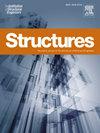Repairing thermally shocked reinforced concrete beams using innovative CFRP sheets anchorage systems
IF 3.9
2区 工程技术
Q1 ENGINEERING, CIVIL
引用次数: 0
Abstract
The primary objective of this study is to investigate the effect of using a CFRP sheet to strengthen/repair thermally shocked lightweight aggregate concrete (LWAC) and normal-weight aggregate concrete (NWAC) beams. It also aims, to evaluate the effectiveness of using an innovative anchorage system on the behavior of CFRP- repaired NWAC and LWAC beams. Eight LWAC beams, in addition to four NWAC beams, were cast, with dimensions of 150 mm × 200 mm × 1150 mm (width × height × length) with a 28-day compressive strength of 30 MPa. Seven LWAC beams and three NWAC beams were heated to 600 °C, followed by 15 min of rapid cooling in water, and six thermally shocked LWAC and one NWAC thermally shocked specimens were repaired with CFRP sheet and different anchorage systems of CFRP sheets and ropes. The anchorage systems used in this study were fan NSM-CFRP rope, four U-Wrapping ropes, one or two fan/ five U-Wrapping ropes, and four U-Wrapping sheets. After that, a four-point loading test was performed on all specimens. Test results illustrated that when CFRP sheets were applied on thermally shocked LWAC and NWAC beams, the mechanical performance of both damaged LWAC and NWAC specimens drastically increased. Furthermore, all innovative anchorage systems considerably enhanced the ultimate load by a percentage of (30 %−84.2 %), stiffness by (14.8 %−59.2 %), and toughness by (6.14 %−22 %) of CFRP-repaired NWAC and LWAC beams compared with thermally shocked LWAC and NWAC beams. Specifically, For LWAC specimens, the best method of repair was the one using a bottom CFRP sheet with two fans and five U-wrapping NSM-CFRP ropes, which increased the ultimate load, stiffness, and toughness by a percentage of roughly 84.2 %, 59.2 %, and 21.93 %, respectively, compared with thermally shocked LWAC beam.
利用创新的 CFRP 片材锚固系统修复热冲击钢筋混凝土梁
本研究的主要目的是调查使用 CFRP 片材加固/修复热冲击轻骨料混凝土(LWAC)和正常重量骨料混凝土(NWAC)梁的效果。研究还旨在评估使用创新锚固系统对经 CFRP 修复的 NWAC 和 LWAC 梁行为的影响。除四根 NWAC 梁外,还浇铸了八根 LWAC 梁,尺寸为 150 毫米 × 200 毫米 × 1150 毫米(宽 × 高 × 长),28 天抗压强度为 30 兆帕。将七根 LWAC 梁和三根 NWAC 梁加热至 600 °C,然后在水中快速冷却 15 分钟,用 CFRP 片材和不同的 CFRP 片材与绳索锚固系统修复六根热冲击 LWAC 试样和一根 NWAC 热冲击试样。本研究中使用的锚固系统包括扇形 NSM-CFRP 绳索、四条 U 型缠绕绳索、一条或两条扇形/五条 U 型缠绕绳索以及四块 U 型缠绕板。然后,对所有试样进行了四点加载试验。试验结果表明,在热冲击 LWAC 和 NWAC 梁上铺设 CFRP 板材后,受损 LWAC 和 NWAC 试样的机械性能均大幅提高。此外,与热冲击的 LWAC 和 NWAC 梁相比,所有创新的锚固系统都大大提高了 CFRP 修复的 NWAC 和 LWAC 梁的极限荷载(30 %-84.2 %)、刚度(14.8 %-59.2 %)和韧性(6.14 %-22 %)。具体而言,对于 LWAC 试样,最佳修复方法是使用带有两个扇形和五条 U 型缠绕 NSM-CFRP 绳的 CFRP 底板,与热冲击 LWAC 梁相比,极限载荷、刚度和韧性分别提高了约 84.2%、59.2% 和 21.93%。
本文章由计算机程序翻译,如有差异,请以英文原文为准。
求助全文
约1分钟内获得全文
求助全文
来源期刊

Structures
Engineering-Architecture
CiteScore
5.70
自引率
17.10%
发文量
1187
期刊介绍:
Structures aims to publish internationally-leading research across the full breadth of structural engineering. Papers for Structures are particularly welcome in which high-quality research will benefit from wide readership of academics and practitioners such that not only high citation rates but also tangible industrial-related pathways to impact are achieved.
 求助内容:
求助内容: 应助结果提醒方式:
应助结果提醒方式:


